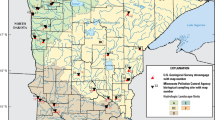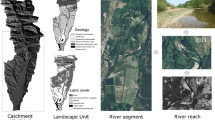Abstract
A method was developed to score the ecological condition of first- to third-order stream reaches in the Auckland region of New Zealand based on the performance of their key ecological functions. Such a method is required by consultants and resource managers to quantify the reduction in ecological condition of a modified stream reach relative to its unmodified state. This is a fundamental precursor for the determination of fair environmental compensation for achieving no-net-loss in overall stream ecological value. Field testing and subsequent use of the method indicated that it provides a useful measure of ecological condition related to the performance of stream ecological functions. It is relatively simple to apply compared to a full ecological study, is quick to use, and allows identification of the degree of impairment of each of the key ecological functions. The scoring system was designed so that future improvements in the measurement of stream functions can be incorporated into it. Although the methodology was specifically designed for Auckland streams, the principles can be readily adapted to other regions and stream types.




Similar content being viewed by others
References
Adamus PR, Clarain EJ Jr, Smith RD, Young RE (1987) Wetland evaluation technique (WET), vol II. Technical report Y-87. U.S. Army Corps of Engineers Waterways Experiment Station, Vicksburg, MS
Allan JD (1995) Stream ecology: structure and function of running waters. Chapman & Hall, London
Barnett AM, Johnston TD, Appy R (1994) Evaluation of the mitigative value of an artificial reef relative to open coast sand bottom by the biological evaluation standardised technique (BEST). Bulletin of Marine Sciences 55:2–3
Bentivoglio A (2003) Compensatory mitigation for coral reef impacts in the Pacific Islands. U.S. Fish and Wildlife, Pacific Islands Fish and Wildlife Office, Honolulu, HI
Brinson MM (1993) A hydrogeographic classification for wetlands. Technical Report WRP-DE-4. U.S. Army Corps of Engineers, Waterways Experiment Station, Vicksburg, VA
Brinson MM, Rheinhardt R (1996) The role of reference wetlands in functional assessment and mitigation. Ecological Applications 6:69–76
Ciesielka IK, Bailey RC (2007) Hierarchical structure of stream ecosystems: consequences for bioassessment. Hydrobiologia 586:57–67
Collier K, Aldridge BMTA, Hicks BJ, Kelly J, MacDonald A, Smith BJ, Tonkin J (2009) Ecological values and restoration of urban streams: constraints and opportunities. New Zealand Journal of Ecology 33 (in press)
Conservation Foundation (1988) Protecting America’s wetlands: an action agenda. Final report of the National Wetlands Policy Forum. Conservation Foundation, Washington, DC
Cowell R (1997) Stretching the limits: environmental compensation, habitat creation and sustainable development. Transactions of the Institute of British Geographers, New Series 22:292–306
Department of Fisheries and Oceans (1986) The Department of Fisheries and Oceans policy for the management of fish habitat. DFO, Ottawa, Canada
Department of Fisheries and Oceans (DFO) (2005) Guidelines on evaluating ecosystem overviews and assessments: necessary documentation. Science Advisory Report No. 2005/026. DFO, Canadian Science Advisory Section, Ottawa
Dunn H (2004) Defining the ecological values of rivers: the views of Australian river scientists and managers. Aquatic Conservation—Marine and Freshwater Ecosystems 14:413–433
European Commission (2000) Directive of the European Parliament and of the Council 2000/60/EC establishing a framework for community action in the field of water policy. European Commission PE-CONS 3639/1/00 REV 1. EC, Luxembourg
Finkelstein M, Bakker V, Doak DF, Sullivan B, Lewison R, Satterthwaite WH, McIntyre PB, Wolf S, Priddel D, Arnold JM, Henry RW, Sievert P, Croxall J (2008) Evaluating the potential effectiveness of compensatory mitigation strategies for marine bycatch. PLoS ONE 3(6):e2480
Furse M, Hering D, Moog O, Verdonschot P, Johnson RK, Brabec K, Gritzalis K, Buffagni A, Pinto P, Friberg N, Murray-Bligh M, Kokes J, Alber R, Usseglio-Polatera P, Haase P, Sweeting R, Bis B, Szoszkiewicz K, Soszka H, Springe G, Sporka F, Krno I (2006) The STAR project: context, objectives and approaches. Hydrobiologia 566:3–29
Harper DL, Quigley JT (2005) No net loss of fish habitat: a review and analysis of habitat compensation in Canada. Environmental Management 36:343–355
Hauer R, Lamberti G (2006) Methods in stream ecology, 2nd edn. Elsevier Academic Press, New York
Hildebrand RH, Watts AC, Randle AM (2005) The myths of restoration ecology. Ecology and Society 10:19. www.ecologyandsociety.org/vol10/iss1/art19/
Hollands GG, Magee DW (1986) A method for assessing the functions of wetlands. In: Kusler JA, Riexinger P (eds) Proceedings of the national wetland assessment symposium, June 17–20, 1985, Portland, ME, pp 108–121
Huggett D (1998) Designing and building dynamic coasts and wetlands: developing a no net loss approach. RAMSAR forum, No net loss and mitigation banking. www.ramsar.org/forum/forum_mitigation/htm
Jorgensen SE, Costanza R, Xu F-L (2005) Handbook of ecological indicators for assessment of ecosystem health. CRC Press, Boca Raton, FL
Joy M, Death R (2004) Application of the index of biotic integrity methodology to New Zealand freshwater fish communities. Environmental Management 34:415–428
Joy M, Henderson R (2004) A fish index of biotic integrity (IBI) for the Auckland region—report and user guide for use with the Auckland Fish IBI software. Centre for Freshwater Ecosystem Modelling and Management, Massey University, Palmerston North
Lake PS, Bond N, Reich P (2007) Linking ecological theory with stream restoration. Freshw Biol 52:597–615
Lange M, Cudmore-Vokey BC, Minns CK (2001) Habitat compensation case study analysis. Canadian Manuscript and Report on Fisheries and Aquatic Science No. 2576
Light A (2000) Ecological restoration and the culture of nature; a pragmatic perspective. In: Gobster PH, Hull RB (eds) Restoring nature: perspectives from the social sciences and humanities. Island Press, St. Louis, MO, pp 49–70
MacDonald A (2006) The influence of agricultural land use on the structure and functioning of small stream ecosystems. Research report submitted toward fulfillment of a BSc(Hons) degree. Massey University, Palmerston North
Meyer JL, Wallace JB (2001) Lost linkages and lotic ecology: rediscovering small streams. In: Press MC, Huntly N, Levin S (eds) Ecology: achievement and challenge. Blackwell Science, London
Meyer JL, Paul MJ, Taulbee WK (2005) Stream ecosystem function in urbanizing landscapes. Journal of the North American Benthological Society 24:602–612
Minns CK (1997) Quantifying “no net loss” of productivity of fish habitats. Canadian Journal of Fisheries and Aquatic Sciences 54:2463–2473
Minns CK (2005) Compensation ratios needed to offset timing effects of losses and gains and achieve no net loss of productive capacity. Canadian Journal of Fisheries and Aquatic Science 63:1172–1182
Minns CK, Moore JE (2003) Assessment of net change of productive capacity of fish habitats: the role of uncertainty and complexity in decision making. Canadian Journal of Fisheries and Aquatic Sciences 60:100–116
Minshall GW, Cummins KW, Petersen RC, Cushing CE, Bruns DA, Sedell JR, Vannote RL (1985) Developments in stream ecosystem theory. Canadian Journal of Fisheries and Aquatic Sciences 42:1045–1055
Moilanen A, van Teeffelen AJA, Ben-Haim, Y, Ferrier S (2008) How much compensation is enough: a framework for incorporating uncertainty and time discounting when calculating offset ratios for impacted habitat. Restoration Ecology. doi:10.1111/j.1526-100X.2008.00382.x
Naiman RJ, Melillo JM, Lock MA, Ford TE, Reice SR (1987) Longitudinal patterns of ecosystem processes and community structure in a subarctic river continuum. Ecology 68:1139–1156
Naiman RJ, Décamps ME, McClain ME, Aronson J (2007) Riparian ecology, conservation and management of streamside communities. Natures Sciences Societies 15:441
Norris RH, Prosser I, Young B, Liston P, Bauer N, Davies N, Dyer F, Linke S, Thoms M (2001) The assessment of river condition (ARC), an audit of the ecological condition of Australian rivers. Final report submitted to the National Land and Water Resources Audit Office. CSIRO Land and Water, Canberra
Paul MJ, Meyer JL (2001) Streams in the urban landscape. Annual Review of Ecology and Systematics 32:333–365
Phillips N, Parkyn S, Smith B (2006) Papakura ICMP—stream management component. NIWA Client Report HAM2006-102. National Institute for Water and Atmospheric Research, Hamilton, New Zealand
Quigley JT, Harper D (2006a) Effectiveness of fish habitat compensation in Canada in achieving no net loss. Environmental Management 37:351–366
Quigley JT, Harper D (2006b) Compliance with Canada’s Fishery Act. A field audit of habitat compensation projects. Environmental Management 37:336–350
Quinn JM, Phillips NR, Parkyn SM (2007) Factors influencing retention of coarse particulate organic matter in streams. Earth Surface Processes and Landforms 32:1186–1203
Roe E, van Eeten M (2003) Some recent innovations in improving ecosystem functions and service reliability. Global Environmental Change 13:155–158
Rowe DK (2003) Ecosystem valuation: a review of methods and recommendations for Auckland streams. NIWA Client Report HAM2003-075. National Institute for Water and Atmospheric Research, Hamilton, New Zealand
Rowe DK, Collier K, Hatton C, Joy M, Maxted J, Moore S, Neale M, Parkyn S, Phillips N, Quinn J (2008) Stream ecological valuation (SEV): a method for scoring the ecological performance of Auckland streams and for quantifying environmental compensation, 2nd edn. Auckland Regional Council Technical Publication No. 302. Auckland Regional Council, Auckland
Roy AH, Freeman MC, Freeman BJ, Wenger SJ, Ensign WE, Meyer JL (2005) Investigating hydrologic alterations as a mechanism of fish assemblage shifts in urbanising streams. Journal of the North American Benthological Society 24:656–678
Smith RD, Ammann A, Bartoldus C, Brinson M (1995) An approach for assessing wetland functions using hydrogeomorphic classification, reference wetlands and functional indices. Wetlands Research Program Technical Report WRP-DE-9. U.S. Army Corps of Engineers, Waterways Experiment Station, Vicksburg, VA
Snelder TH, Biggs BJF (2002) Multi-scale river environment classification for water resources management. Journal of the American Water Resources Association 38:1225–1240
Storey R (2007) Waitakere City stream survey and asset assessment. Evaluation of year one streams based on the stream ecological valuation (SEV) methodology. NIWA Client Report HAM2008-003. National Institute for Water and Atmospheric Research, Hamilton, New Zealand
Strange E, Galbraith H, Bickel S, Mills D, Beltman D, Lipton J (2002) Determining ecological equivalence in service-to-service scaling of salt marsh restoration. Environmental Management 29:290–300
U.S. Environmental Protection Agency (USEPA) (1989) MIST: a methodology to classify pre-project mitigation sites and develop performance standards for the construction and restoration of forested wetlands. In: White TA, Allen JA, Mader SF, Mengel DL, Perison DM, Tew DT (eds) Results of an EPA sponsored workshop, Atlanta, Georgia. USEPA, Washington, DC
Wilding S, Raemaekers J (2000) Environmental compensation for greenfield development: is the devil in the detail. Planning Practice and Research 15:211–231
Wilson MA, Carpenter SR (1999) Economic valuation of freshwater ecosystem services in the United States: 1971–1997. Ecological Applications 9:772–783
World Wildlife Fund (WWF) (1992) State-wide wetland strategies: a guide to protecting and managing the resource. Island Press, Washington, DC
Young R, Townsend C, Matthaei (2004). Functional indicators of river ecosystem health—an interim guide for use in New Zealand. Cawthron Report No. 870. Cawthron Institute Nelson, New Zealand
Acknowledgments
We thank Mike McMurtry and Joanne Wilks of the Auckland Regional Council for their assistance with fieldwork and Ngaire Phillips at NIWA (Hamilton) for her input into the refinement and standardization of the variable measuring methods. The development of this method was funded primarily by the Auckland Regional Council, with the New Zealand Foundation for Research Science and Technology supporting its publication through Contract No. CO1X0305.
Author information
Authors and Affiliations
Corresponding author
Rights and permissions
About this article
Cite this article
Rowe, D.K., Parkyn, S., Quinn, J. et al. A Rapid Method to Score Stream Reaches Based on the Overall Performance of Their Main Ecological Functions. Environmental Management 43, 1287–1300 (2009). https://doi.org/10.1007/s00267-009-9302-z
Received:
Revised:
Accepted:
Published:
Issue Date:
DOI: https://doi.org/10.1007/s00267-009-9302-z




